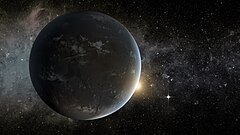Kepler-62f
| ||
 Artystyczna wizja planety Kepler-62f | ||
| Odkrywca | Kosmiczny Teleskop Keplera | |
| Data odkrycia | 2013 | |
| Charakterystyka orbity (J2000) | ||
| Półoś wielka | 0,718 ± 0,007 au | |
| Okres orbitalny | 267,291 ± 0,005 | |
| Czas tranzytu | 2 455 422,71 ± 0,06 JD | |
| Nachylenie orbity | 89,9 ± 0,03° | |
| Charakterystyka fizyczna | ||
| Masa | < 0,11 MJ < 35 M⊕ | |
| Promień | 0,126 ± 0,006 RJ 1,41 ± 0,07 R⊕ | |
| Temperatura powierzchni | 208 ± 11 K | |
Kepler-62f (również znana jako KOI-701.04) – planeta pozasłoneczna zaliczana do typu superziem, o promieniu 1,4 razy większym od promienia Ziemi. Krąży na orbicie wokół gwiazdy Kepler-62 i jest najdalszą z pięciu znanych planet tego systemu. Kepler-62f znajduje się około 1200 lat świetlnych (370 pc) od Ziemi w gwiazdozbiorze Lutni[1]. Istnienie tej planety stwierdzono za pomocą metody tranzytu dzięki danym z Kosmicznego Teleskopu Keplera. Kepler-62f jest najprawdopodobniej planetą krążącą w ekosferze gwiazdy[2], a jej indeks ESI wynosi 0,67[3].
Przypisy
- ↑ 3 Potentially Habitable 'Super-Earths' Explained (Infographic)
- ↑ Kepler-62f: A Possible Water World
- ↑ The Habitable Exoplanets Catalog (ang.). Planetary Habitality Laboratory. [dostęp 2014-01-01].
Bibliografia
- W. J. Borucki et al.. Kepler-62: A five-planet system with planets of 1.4 and 1.6 Earth radii in the Habitable Zone. „Science”. 340 (6132), s. 587-590, 2013-05-03. DOI: 10.1126/science.1234702 (ang.).
- Kepler-62f w serwisie The Extrasolar Planets Encyclopaedia (ang.) [dostęp 2013-12-31]
Media użyte na tej stronie
Kepler-62f with 62e as Morning Star
http://www.nasa.gov/mission_pages/kepler/multimedia/images/kepler-morningstar.html
http://www.nasa.gov/images/content/742541main_Kepler-62MorningStar-1_full.jpg
The artist's concept depicts NASA's Kepler misssion's smallest habitable zone planet. Seen in the foreground is Kepler-62f, a super-Earth-size planet in the habitable zone of a star smaller and cooler than the sun, located about 1,200 light-years from Earth in the constellation Lyra.
Kepler-62f orbits its host star every 267 days and is roughly 40 percent larger than Earth in size. The size of Kepler-62f is known, but its mass and composition are not. However, based on previous exoplanet discoveries of similar size that are rocky, scientists are able to determine its mass by association.
Much like our solar system, Kepler-62 is home to two habitable zone worlds. The small shining object seen to the right of Kepler-62f is Kepler-62e. Orbiting on the inner edge of the habitable zone, Kepler-62e is roughly 60 percent larger than Earth.
Image credit: NASA Ames/JPL-Caltech